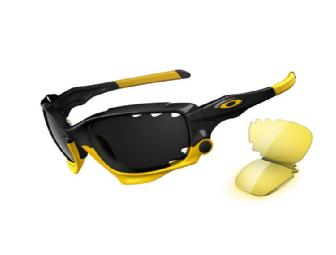Clothing/Accessories
BRAND NEW - OAKLEY SUNGLASSES LIVESTRONG JAWBONE
- Item Number
- 340
- Estimated Value
- 210 USD
- Sold
- 160 USD to tyfamily
- Number of Bids
- 11 - Bid History
Item Description
LIVESTRONG JAWBONE SUNGLASSES
Oakley’s legacy of sports performance innovation continues with the new JAWBONE. The latest evolution of a coveted design, this frame is like nothing ever seen in the world of sports. Every aspect is engineered around the clarity and protection of HIGH DEFINITION OPTICS® (HDO®).
With Oakley’s new SWITCHLOCK™Technology, the lower part of the frame rim opens to allow easy access for quick lens changing, letting you optimize performance in any light condition. The revolutionary design holds the lenses with a suspension system so stresses on the frame won’t affect the optics. With ordinary frames, flexing can change the surface contours of the lenses, causing optical distortion. The new architecture ensures there’s nothing to diminish the unbeatable clarity of HIGH DEFINITION OPTICS® (HDO®), and you still get the optimized comfort and fit of a flexible frame design.
Pivot the nose piece to unlock the lower jaw and open it for easy lens changing. There’s minimal handling involved, so dirty fingers don’t get all over the lens. The quick-release system closes with a cam that locks each lens securely in place.
Oakley engineered the pivoting system with a release mechanism that lets you remove and replace the nose piece with a different size to customize the fit. A comfortably secure fit is essential for athletic competition, so Oakley started this new design with the company’s legendary Three-Point Fit. Instead of hooking the ears like conventional frames, a Three-Point Fit ensures the frame touches the wearer only at the bridge of the nose and the sides of the head. Oakley combined the proprietary fit with specialized bridge geometry and strategically placed flex zones to give the frame a broad range of flexibility while directing stresses away from the lenses. That way, the optics can do their job without the distortion of subtle bending and bowing.
Roosevelt Elementary Booster Club stores data...
Your support matters, so Roosevelt Elementary Booster Club would like to use your information to keep in touch about things that may matter to you. If you choose to hear from Roosevelt Elementary Booster Club, we may contact you in the future about our ongoing efforts.
Your privacy is important to us, so Roosevelt Elementary Booster Club will keep your personal data secure and Roosevelt Elementary Booster Club will not use it for marketing communications which you have not agreed to receive. At any time, you may withdraw consent by emailing Privacy@frontstream.com or by contacting our Privacy Officer. Please see our Privacy Policy found here PrivacyPolicy.


